SLOs and Reliability Engineering: How Nobl9’s Marketing Approach is Transforming the SRE Community – VMblog QA
2025-05-01T15:44:00Z
To hear the latest on how SLOs support reliability, and what marketing to the unique community of SREs, we talked with Erza Zylfijaj, Marketing Program Manager for Nobl9, the Service Level Objective (SLO) company.
Service Level Objectives (SLOs) are a way to define and measure the reliability of a service, ensuring it meets user expectations. They are a key component of Site Reliability Engineering (SRE) practices, helping to balance feature velocity with system stability. As systems become more complex, the need for strong SRE practices and using SLOs for reliability is becoming more important than ever.
To hear the latest on how SLOs support reliability, and what marketing to the unique community of SREs, we talked with Erza Zylfijaj, Marketing Program Manager for Nobl9, the Service Level Objective (SLO) company.
++
VMblog: Can you tell us a little about your background and how you got involved in the reliability and SRE space?
Erza Zylfijaj: I’ve been leading marketing programs at Nobl9, where we help companies operationalize reliability through service-level objectives (SLOs). I joined the team early on, as one of the first two members of the marketing team, which gave me a front-row seat to building out the foundation, from digital strategy and messaging to social, web, and community.
My entry into the SRE world came through Nobl9’s mission to elevate reliability beyond just reactive incident management, focusing instead on improving the overall customer experience. I also co-organized SLOconf, a free, community-led virtual conference that’s grown to 2,000+ attendees globally. My work lives at the intersection of marketing, developer relations, and community-building, with a focus on translating complex reliability concepts into something actionable and relatable for both engineers and business leaders.
VMblog: What are some of the unique challenges when marketing to engineers and the SRE community?
Zylfijaj: You can’t fake it. Engineers and especially SREs have a sharp radar for anything that feels overly polished or lacking substance. They don’t want to be sold to. For that reason, traditional marketing doesn’t always work here. You have to earn their trust by delivering real value: sharing lessons learned, building useful community resources, and spotlighting real-world implementations.
If you look at the webinars and meetups I’ve hosted over the years, the themes vary, from AI’s impact on reliability to DORA compliance and postmortem strategies. But they all have one thing in common: they’re rooted in practical insight from practitioners who’ve been in the trenches.
Content has to be grounded in what actually works, not buzzwords or fluffy narratives. That’s why we at Nobl9 lead with education-first initiatives and consistently amplify the voices of those doing the work rather than just promoting our product.
VMblog: You helped grow SLOconf into a global event. What lessons did you learn about community-building in the SRE space?
Zylfijaj: The biggest takeaway: community isn’t something you launch, it’s something you serve. With SLOconf, we focused on creating space for real conversations, not vendor pitches. That meant making it free, curating a diverse speaker lineup, and prioritizing knowledge sharing over self-promotion. We also put a lot of energy into listening and evolving the event based on feedback. People showed up because it felt authentic and useful, not because we marketed it the hardest.
VMblog: In your view, why are SLOs becoming more important for modern reliability engineering?
Zylfijaj: SLOs let teams shift from reactive “whack-a-mole” mode to proactive reliability management. Instead of chasing every alert or aiming for “perfect,” you align your goals with what actually matters to the user experience. With increasingly complex systems, microservices, distributed teams, and third-party dependencies, you need a framework that helps teams prioritize what’s most impactful. SLOs provide that clarity. They also bridge the gap between engineering and business goals, which is critical for scaling reliability efforts strategically.
VMblog: So, can you give an example of how SLOs helped a team move from reactive to proactive reliability management?
Zylfijaj: Sure. For instance, a team managing an API service noticed high alert fatigue, and engineers were constantly on call, reacting to minor latency spikes. After defining an SLO around 99.9% request success rate, they began focusing only on error rates that would breach that threshold. This reduced noise significantly and allowed the team to focus on improvements like database tuning and better caching strategies. Instead of reacting to every issue, they worked on what truly affected the customers and the user experience.
VMblog: What advice would you give to companies looking to better engage with technical audiences like SREs?
Zylfijaj: Start with the assumption that your audience is smart and short on time. Lead with content that teaches, not sells. Share lessons from real practitioners. Elevate the voices of engineers doing the work. Be consistent in showing up with value, whether through webinars, open Q&As, or even just thoughtful documentation. And now more than ever, with AI changing how we market, try to avoid buzzwords. Engineers care about solving problems. If you help them do that, they’ll pay attention to you.
##
Auto-posted from news source




